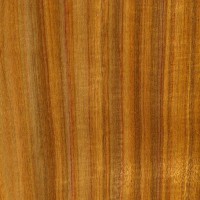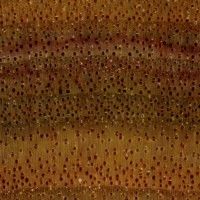 |
Common Name(s): Canarywood, Canary Scientific Name: Centrolobium spp. Distribution: South America (from Panama down to southern Brazil) Tree Size: 65-100 ft (20-30 m) tall, 2-3 ft (.6-1.0 m) trunk diameter Average Dried Weight: 52 lbs/ft3 (830 kg/m3) Specific Gravity (Basic, 12% MC): .65, .83 Janka Hardness: 1,520 lbf (6,750 N) Modulus of Rupture: 19,080 lbf/in2 (131.6 MPa) Elastic Modulus: 2,164,000 lbf/in2 (14.93 GPa) Crushing Strength: 9,750 lbf/in2 (67.2 MPa) Shrinkage: Radial: 2.4%, Tangential: 5.6%, Volumetric: 8.4%, T/R Ratio: 2.3 |
Color/Appearance: Heartwood color can vary a fair amount, from a pale yellow-orange to a darker reddish brown, usually with darker streaks throughout. Pale yellow sapwood is sharply demarcated from heartwood. Color tends to darken and homogenize with age: see the article Preventing Color Changes in Exotic Woods for more information.
Grain/Texture: Grain is typically straight, but can be irregular or wild on some pieces. Uniform fine to medium texture with good natural luster.
Endgrain: Diffuse-porous; large pores in no specific arrangement, few; solitary and radial multiples of 2-3; mineral/gum deposits occasionally present; growth rings indistinct; rays not visible without lens; parenchyma varies depending on species: can be vasicentric, aliform, and confluent.
Rot Resistance: Rated as very durable in regard to decay resistance, as well as being resistant to termite and marine borer attack.
Workability: Easy to work with both hand and machine tools, though some tearout can occur during planing on pieces with wild or irregular grain. Good dimensional stability. Turns, glues and finishes well.
Odor: Canarywood has a distinct scent when being worked.
Allergies/Toxicity: Besides the standard health risks associated with any type of wood dust, no further health reactions have been associated with Canarywood. See the articles Wood Allergies and Toxicity and Wood Dust Safety for more information.
Pricing/Availability: Generally available in good sizes of lumber, and occasionally also offered as turning blanks. Prices should be moderate for an imported hardwood.
Sustainability: This wood species is not listed in the CITES Appendices or on the IUCN Red List of Threatened Species.
Common Uses: Construction lumber, railroad crossties, flooring, veneers, boatbuilding, furniture, cabinetry, and turned items.
Comments: Some pieces of Canarywood can be almost rainbow colored—with dark red streaks, along with the natural orange, yellow, and brown coloration.
Canarywood is said to have good acoustic properties, and is sometimes used for speaker enclosures and entertainment system cabinets.
None available.
Scans/Pictures: A special thanks to Justin Holden for providing the wood sample of this wood species.









Anyone ever try canary wood for a solid body electric guitar? Just got a piece for a small cabinet, and it occurs to me it would be a striking instrument…(corrected my email address)
I have a number of pieces of canarywood from widely varying sources, and they all have an average dried weight of 41 – 47 lbs/ft3. Most are around 43-44. I don’t have anything close to 52 of all the pieces I’ve measured and weighed. Where does the 52 lbs/ft3 come from? Is it accurate?
Canarywood color and density varies widely. I have used it for close to 20 years in making custom game calls (primarily wild turkey calls). It does have wonderful tonal qualities for this use. While the pieces with sapwood can be visually stunning, these tend to be less dense and tonal qualities (for my purpose) are not as good.
I have a 6′ x 13″ x 1.25″ piece of Canarywood with exceptionally brilliant hues of red and brown saddled with yellow/goldish bands and “blonde” edges. A client asked me if I could build a console table using this piece but with the colors darkened a bit. Or, stated differently, darken the wood while maintaining high contrast. Of course my response was, “oh yeah, all day long.” However, I have no idea on how to achieve the desired look without overly “browning” the piece. Maybe isolated finishes to the separate areas with a topcoat? Any insight or reference would be… Read more »
I’ve been writing with Canarywood for a few weeks now. It’s a pleasure to work with. He is an example from making a shot glass.
Hi Daniel,
Do you have to have a lathe or wood turning device to make these shot glasses?
Michael Dorr
What domestic wood is closest in density to Canary wood?
Here’s a list of NA woods that are within +/- 5 lbs/ft3 dried weight.
https://www.wood-database.com/wood-filter/?fwp_location=north-america&fwp_average_dried_weight=47.00%2C57.00
Thank you.
I am planting this marvelous tree here in Brazil..growths fast!!
I used it for the back and sides of a Venezuelan cuatro. It’s a hard wood to bend. The final sound was also a little too bright, with lower volume. But it was beautiful to look at, lots of highlights and color variations.
Made a lovely turned pepper grinder out of canarywood. Turning was easy and the finish (with melamine lacquer and no undercoating/filler) was beautiful. The pores give it a lot of interest.
Canarywood nose irritation.
I like working with canarywood. It turns nice for pens. The little fissures keep it from having a super-smooth, glossy finish, but its colour is a nice change from browns, blacks and reds.
But canarywood doesn’t like me. If I’m not wearing a mask when drilling or sanding canarywood, within five seconds the dust feels like needles being poked up my nose. (Same as when I was a kid waking up to my dad’s cowboy coffee every morning.)
Other than that………………..great stuff.
I just made a hickory backed Canarywood longbow. It’s a thing of beauty and shoots quite well.
I have noticed the dust is irritating as well. I splinter felt like a bee sting until I removed it. I chose this wood for its coloring and grain pattern for a urn. I have also noticed the acoustical properties. I build architectural wood panels and diffusers for theaters.
The look of some Canary wood reminds me of Tulipwood, but it’s a lot cheaper and easier to find.
I have only turned one piece of canarywood. However, I think it was by far the most pleasant experience. The wood turned smooth, and the sweet smell in the air was quite amazing. I made a pretty slick looking police baton out of it. I noticed all of the blanks had insect holes and chose one with the least Is this pretty common with canarywood? I simply sanded smooth and used the wood dust to fill several holes. It made for a great piece.
You should try sugar maple, Brazilian rosewood, or elm. The smells they give off is amazing and a bit like a bakery.
Canarywood is quite good acoustically speaking, and made a nice sounding (and looking) guitar. It does seem to split rather easily, but otherwise is easy to work with, and it was easy to bend the sides on a hot pipe with a spritz of water.
I have had a similar experience I dropped a piece on the concrete floor and it had a nice clean sound. So I am going to use some for a sound box on a stringed instrument. I just started today on the project, so I have no data to pass on at this time.
I use this wood for turning bowls and lidded jars, going to try doing threaded stuff as well. It is the wood I go to most when I want to turn something easy that will come out looking nice regardless of simplicity in the design I create on the object I am making.
One thing I notice, strong it is, but can easily chip off sharp edges in large chunks. In other words, when I am turning square pieces on the lathe, like no other wood, this can tear out large chunks. Kind of like an overly brittle rock.
Robert, I actually have a funny story about this subject: I was making bowed psalteries (https://www.apsimplepsaltery.com) and by accident I knocked some thin strips of Canarywood on the concrete floor, and remarked at how acoustically-pleasing the sound was.
I guess I don’t have any official way of measuring it, but I consider Canarywood to be a decent tonewood; very similar to Padauk to my ears.
I have been given two canary wood planks, 2″ x 6″ x 72″. They have been planed and appeared to have been kiln dried. I was planning on making a xylophone, and was wondering if this wood would be a good choice for the note bars (1 3/16″ x 5/8″ x various lengths).
Sincerely,
Robert
I like working with this wood. I have been cutting it with a scroll saw. It cuts and finishes very well. I have cut fretwork butterflies from 1/4″ thickness and fretwork crosses from 3/4″ thickness. The rainbow colored makes great butterflies. The only problem I have with this wood is I have to wash all the sawdust off my bare skin about every 30 minutes because it causes me to itch very much. This is the only wood I have used so far that has caused this problem.